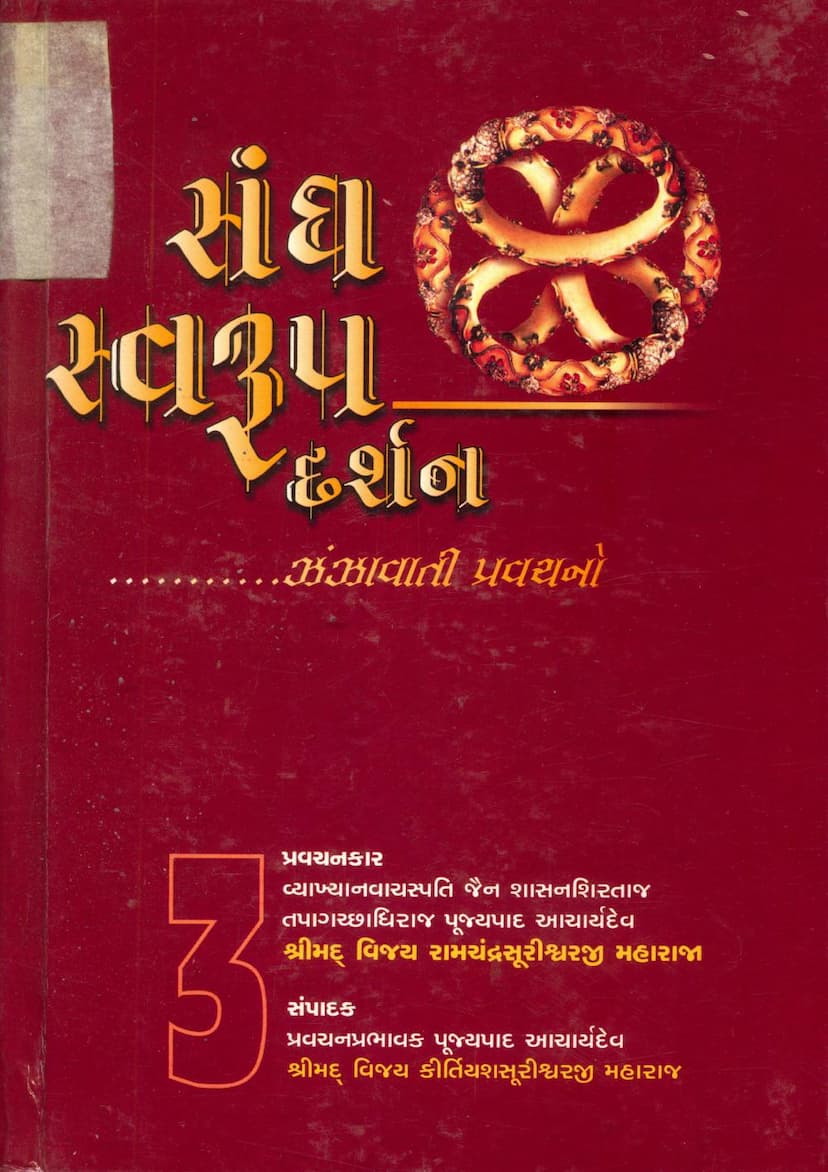Sangh Swarup Darshan Part 03
Added to library: September 2, 2025

Summary
This is a comprehensive summary of the Jain text "Sangh Swarup Darshan Part 03" by Kirtiyashsuri, published by Sanmarg Prakashan. The text is a collection of sermons delivered by Acharya Shri Vijay Ramchandrasurishwarji Maharaj.
Overall Purpose and Theme:
The primary purpose of this text is to elucidate the true nature, significance, and duties of the Jain Sangh (community), which is composed of fourfold members: Sadhus, Sadhvis, Shravaks, and Shravikas. It emphasizes the importance of adhering to the principles of Jainism, particularly in the context of evolving societal norms and challenges. The sermons aim to guide the followers towards understanding their role within the Sangh and to encourage sincere spiritual practice for the ultimate goal of liberation (Moksha).
Key Concepts and Arguments:
- The Sangh as a Supreme Entity: The text repeatedly highlights the exalted status of the Sangh, referring to it as being worshipped by celestial beings (Devendra, Narendra) and even saluted by Tirthankaras. It is described as being like a city, a chakra (wheel), a chariot, a lotus, the moon, the sun, the ocean, and Mount Meru, each metaphor illustrating its protected, well-ordered, liberating, pure, radiant, vast, and stable nature.
- The Importance of Rules and Discipline (Niyam): A central theme throughout the sermons is the indispensable role of rules and self-discipline (Niyam) in Jain life. The text argues that rules govern the senses and the mind, leading to spiritual progress. It criticSzes those who shy away from rules, deeming them incompatible with the Jain way of life. Acharya Shri Ramvijayji Maharaj is portrayed as a strong proponent of adhering to spiritual discipline, even when facing opposition.
- Distinguishing True Jainism from Modern Trends: The text addresses the challenges posed by contemporary societal changes and "reformers" who seek to dilute or alter Jain principles. It criticizes the tendency to prioritize worldly knowledge or modern education over spiritual adherence, especially when it compromises fundamental Jain tenets like ahimsa and the renunciation of worldly pleasures. The text distinguishes between superficial adherence and genuine spiritual realization.
- The Significance of Faith and Devotion: A strong emphasis is placed on unwavering faith in the teachings of the omniscient Tirthankaras and the guidance of true spiritual leaders (Gurus). The sermons highlight that true knowledge and spiritual progress stem from faith, not just intellectual understanding or adherence to rituals without the right intention.
- The Nature of the Soul and Karma: The text touches upon the concept of the soul and its journey, emphasizing that liberation comes from understanding the true nature of reality and diligently practicing virtuous conduct. It explains how actions (karma) bind the soul and how through right conduct (Niyam, Samyagdarshan, Jnana, Charitra), one can break free from this cycle.
- Daya (Compassion) – Its True Nature: The sermons delve into the concept of Daya, distinguishing between outward rituals (Dravya Daya) and inner spiritual feelings (Bhava Daya). It stresses that true compassion originates from inner spiritual transformation and cannot be superficial or motivated by worldly gain.
- The Role of the Guru and the Sangh: The importance of a true Guru and the collective strength of the Sangh are emphasized. The Sangh, when united and guided by proper principles, can overcome challenges and lead its members towards spiritual advancement. The sermons also caution against following or giving credence to those who distort or misinterpret religious teachings for personal gain.
- The Pursuit of Moksha: The ultimate goal of all Jain practices is liberation (Moksha). The text guides the readers to understand that worldly pursuits (Artha and Kama) are ultimately transient and can even lead to spiritual downfall if not managed with detachment. The true and lasting happiness lies in the path towards Moksha, which is achieved through righteous conduct and the purification of the soul.
- Addressing Criticisms and Misconceptions: The text actively addresses contemporary criticisms and challenges to Jainism, such as the perceived irrelevance of ancient scriptures in modern times or the debate around certain practices. It offers reasoned explanations and refutes misguided notions to uphold the integrity of the Jain tradition.
- The Importance of Intent and Practice: The sermons consistently highlight that mere intellectual knowledge or outward adherence to rituals is insufficient. True understanding and progress come from cultivating inner conviction, right intention (Bhava), and consistent practice (Anushthan).
Structure and Style:
The text is structured as a series of sermons (Pravachans), compiled and edited by Acharya Shri Vijay Kirtiyashsureshwarji Maharaj under the guidance of Acharya Shri Vijay Ramchandrasurishwarji Maharaj. The language is Gujarati, presented in a clear and accessible style, interspersed with scriptural references and practical examples to illustrate spiritual concepts. The sermons are divided into numbered chapters (Pravachans), covering a wide range of topics related to Jain philosophy and practice.
Key Individuals Mentioned:
- Acharya Shri Vijay Ramchandrasurishwarji Maharaj: The primary speaker whose discourses form the basis of the text.
- Acharya Shri Vijay Kirtiyashsureshwarji Maharaj: The editor of the discourses.
- Acharya Shri Vijay Vijayachandrasurishwarji Maharaj: The author of the introductory section and a key figure in refuting modern deviations.
- Various Munis and Scholars: Throughout the text, references are made to historical figures and teachings from Jain scriptures and commentaries.
In essence, "Sangh Swarup Darshan Part 03" is a profound spiritual guide that aims to deepen the understanding and practice of Jainism by elaborating on the responsibilities, ideals, and ultimate goals of the Jain community, emphasizing the importance of adherence to principles, introspection, and the unwavering pursuit of spiritual liberation.